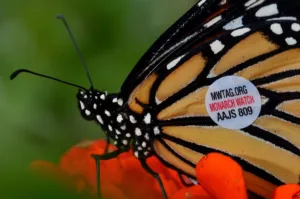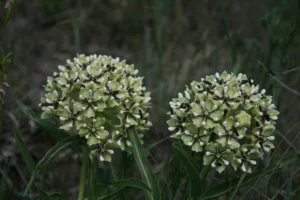
Fall migrating monarchs pass through Texas, overwinter Mexico and return to Texas in the spring looking for milkweed (Asclepius species). Milkweed is the only host plant that monarchs utilize for their life cycle. Abundance of milkweed in Texas is crucial for the development of the first generation of monarchs.
In 2010, the monarch butterfly was added to the World Wildlife Fund’s Ten Most Threatened Species List, due to loss of habitat necessary for survival of the monarch migration.
According to WWF, “Every year millions of delicate monarch butterflies (Danaus plexippus) migrate from North America to their winter habitat in Mexico. A well conserved and protected high-altitude pine and fir forest in Mexico is essential for the survival of the over wintering of monarchs, which has been recognized as an endangered biological phenomenon. The protection of its reproductive habitats in the United States and Canada is also crucial to saving this species migration, one of the most remarkable natural phenomena on the planet.”
The monarch is best known for its amazing migration of up to 2600 miles, navigating by unknown means to a place where none of the individual butterflies have ever been. How do they know where to go? How do they navigate? Scientists are working on it, but, as yet, there is no definite answer. It is truly one of the most amazing migrations of any creature on earth!
In the fall the remarkable monarchs, which weigh about a half of a gram, migrate through Texas to their overwintering sites in the transvolcanic mountains in the state of Michoacan in central Mexico, about 100 miles west of Mexico City. Monarchs don’t tolerate freezing weather so they must migrate to a warmer climate to survive. At an attitude of 10,000 to 12,000 feet, the monarchs cluster in oyamel fir trees for warmth. They have fat stores which they utilize during their 4 month dormancy.
Toward the end of February, they become active, looking for water and looking for mates. After mating, they will stream out of the mountains and head north toward Texas looking for milkweed.

There are over a 100 species of milkweed in the Americas. The predominant milkweed in the central flyway of Texas is antelope horns (Asclepius asperula). Hierba de Zizotes (A. oenotheroides) and green milkweed (A. viridis) are also found.
Spring migrating monarchs arrive in Texas during the last days of March. The females will lay their eggs only on milkweed. The eggs will hatch and small caterpillars will emerge. Monarch larvae are “eating machines” and will devour enough milkweed to grow 2000 times in weight. The monarch caterpillar will leave the milkweed plant to pupate, forming a pupa or chrysalis. It takes about a month from the time the egg is laid to the time the adult butterfly emerges or ecloses from the chrysalis.
Monarchs that are “born” in Texas will live about a month. They will mate and lay eggs as they continue the spring migration northward. It usually takes two generations to reach the upper Midwest and Lower Canada.
The WWF Mexico has just reported the status of the over wintering colony. The good news is the colony has grown to 4.02 hectares (9.9 acres) in 2010 – 2011 compared to 1.92 hectares (4.7 acres) in 2009 – 2010. Since record keeping started in 1994 – 1995, 1.92 hectares is the smallest colony ever recorded. The bad news is 4.02 hectares is the fourth smallest number. Even though the colony size more than doubled in 2010 – 2011, the size of the colony has been below the average for the past seven years.
Dr. Lincoln Brower, an expert on monarch butterflies and Emeritus Distinguished Service Professor, Department of Zoology, University of Florida, stated “What is ominous is that all of the last seven years have been below average.” He points to several possibilities for the decline: climate changes, deforestation, and the existence of genetically modified crops and pesticides, which crowd out the milkweed plants where monarchs lay their eggs. (The Canadian Press, Feb. 14, 2011).
Dr. Orley (Chip) Taylor, Monarch Watch, University of Kansas, stated that threats to monarchs are primarily related to changes in land use or land management practices, including illegal logging, genetically modified, herbicide tolerant crops, and development of rural land. In addition, there are environmental perturbations and potential climate change. Monarch habitat four times the size of the State of Illinois has been lost in the past 18 years in the USA.
What can you do to help the monarch?
Simply put, monarchs need milkweed and nectar plants for survival.
You can create a Monarch Waystation, using the information found at the Monarch Watch website (www.monarchwatch.org).
To offset the loss of milkweeds and nectar sources we need to create, conserve, and protect milkweed/monarch habitats. We need you to help us and help monarchs by creating ‘Monarch Waystations’ (monarch habitats) in home gardens, at schools, businesses, parks, zoos, nature centers, along roadsides, and on other unused plots of land. Without a major effort to restore milkweeds to as many locations as possible, the monarch population is certain to decline to extremely low levels.
